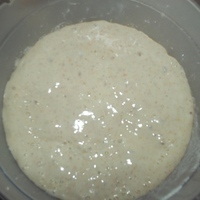
Ingredients
- 1 1/3 cup whole wheat flour
- 3/4 cup tap or distilled water
- cheese cloth
- container - I used a plastic pitcher for this recipe with a lid that allows for air to seep into it, once in the fridge
- unbleached flour
- water
- Daily feeding: 1/3 cup unbleached all purpose flour, 1/4 cup water
Sourdough Starter for Beginners
Directions
- Mix the whole wheat flour with the water.
- Stir well to areate the mixture.
- Cover the container with cheesecloth - see photos.
- Place the container outside, preferably, so it can catch the lactobacilli and yeast spores fom the air. This only works above 60 F and below 95 F. Otherwise, keep it indoors.
- Stir your starter after first 24 hours, re-cover. Feed 24 hours later.
- Hereafter daily: pour out 1/3 of the starter, add 1/3 cup flour, 1/4 cup water, stir well. I save the poured out starter in the fridge for recipes that don't require it to leaven, like pancakes and biscuits.
- The ideal consistency for your starter is like a thick pancake batter.
- If you have some time weekends, do the feedings 2x a day.
- A starter is active when it produces bubbles and foam after a few hours.
- Repeat this daily feeding until the starter starts to smell like sourdough. It's up to you how much longer you want to feed to make the starter stronger. This recipe worked for me after 23 days, but I like a robust sourdough smell. You may not get that type of smell, but just taste a bit of the starter, and it should have a sour taste.
- When you are satisfied, begin using your starter, then refrigerate it for up to 2 weeks, allowing only a bit of air to permeate the container.
- If the starter develops a greyish liquid along the way, called hootch (it's alcohol), just pour it out and feed. If the hooch is any other color, start over from scatch.
- Do not let your starter get too thin, or the starter will get out of balance and perhaps die. It needs fresh flour and water to work.
- If your starter smells like anything other than alcohol (sort of like beer) or sourdough, err on the side of caution and throw it out. It's only the loss of some flour and water.
- Lastly, your starter may never have much of a smell. The type flour you use, the temperature, etc., all influence the starter activity.
- To use and maintain your starter:
- 1. Feed it 1/3 cup flour and 1/4 cup flour.
- 2. When foamy, remove what you want for your recipe.
- 3. Stir, and re-feed. When it is active again, stir.
- 4. Cover and refrigerate.
- 5. If not using starter for long periods (2-3 weeks), take out of fridge occasionally, let return to room temp, stir in 1/3 cup flour and 1/4 cup water.
- 6. When foamy, it is active.
- 7. Any time you feed or use it, follow the same instructions to return to room temp, feed, use part of it, or put re-fed starter back in the fridge.
- If you need any help, email me and describe exactly what the problem is.
Summary
I've had the same starter for over two years, and have been experimenting with several ways for the novice to make his/her own homemade one.
Keeping in mind that you don't want to spend a lot of time getting one going, and maintaining it because of infrequent use, this one is a winner.
It may take many days to get a good sourdough smell from your starter, but simply take a taste after a few days, and if you get a beer-like taste, you're on the right road.. The upside is it only takes 1-2 minutes a day to fool with it.
Some of my posted sourdough recipes suggest using yeast, but if you have 12-24 hours and 80- 85 F temp to let your bread rise naturally, leave the yeast out of the mix.
Note: I bought 2 plastic pitchers at the Dollar Store, so I would always have a clean one to transfer the starter to on occasion. This prevents mold.
If you have kids, this is a great science project, or something fun for them to do at home.